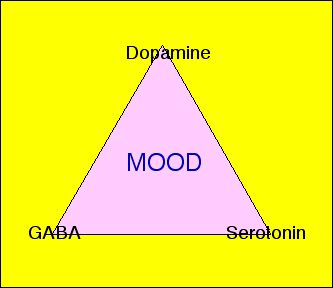Neurotransmitters and Mood in Animals
 |
The "mood triangle" often used to depict how three
major neurotransmitters interact in determining mood. While applied most
frequently to humans, pharmacological studies and veterinary practice
indicates that some of the same principles apply to many, perhaps most,
mammals, although the exact behavioral effects can vary dramatically (Overall
2000). These same neurotransmitters are present in the brains of other
animals, such as birds, but their role in regulating behavior is less
well understood in non-mammals. |
Serotonin is the most commonly manipulated neurotransmitter
in pharmacological interventions in animals. Selective Serotonin Reuptake Inhibitors
(SSRI's), which are commonly used as antidepressants in humans, are effective
in moderating aggression in dogs. Clomimaprine, an older drug which also affects
serotonin-based behavioral responses is commonly used in dogs to treat anxiety.
In humans, clomipramine has been used to treat depression and obsessive compulsive
disorder, although it (and other tricyclics) have largely been replaced by SSRI's
in the treatment of human depression. There is thought that sometimesaggression
in dogs may be a response to anxiety; if this is true, this would explain the
efficicacy of serotonin-related treatments on aggression (eg, Overall and Dunham
2002). In mice, the expression of "anxiety" is higher in strains which
have been genetically selected to be non-aggressive (Nyberg et al. 2003). While
this anxiety/aggression relationship is the opposite of that suggested for dogs,
the existence of a correlation between these two factors does imply a similarity
in how these behaviors are controlled in the two species.
Dopamine is most commonly thought of in the context of Parkinson's
disease in humans. Parkinson's, a progressive loss of muscular control due to
death of the cells in the brain which produce dopamine, can be counteracted
to a certain extent by treatment with compounds that supplement brain dopamine,
such as L-dopa. Because of its link to Parkinson's, physicians treating humans
are justifiably wary of prescribing drugs which lower dopamine levels, even
though dopamine is known to also modulate mood and behavior. An exception is
made for patients with severe pychoses (hallucinations, loss of contact with
reality, such as hearing voices); antipsychotics such as clozapine bind the
dopamine receptor, effectively reducing dopamine concentrations. In dogs, selegiline
hydrochloride, a drug developed as a Parkinson's treatment for humans, may enhance
training (Mills and Ledger 2001).
GABA is most strongly associated with wakefullness/sleepiness.
Hypnotic sleep aids such as Ambien activate GABA receptors, imitating the effect
of increased GABA concentrations. Low GABA may also be associated with depression.
In animals, low GABA levels are, generally, associated with aggression, and
treatments which increase GABA (or bind GABA receptors, mimicking the effect
of GABA) lower aggression (Miczek et al. 2003).
Miczek KA, Fish EW, De Bold JF 2003 Neurosteroids, GABA(A) receptors, and escalated
aggressive behavior HORMONES AND BEHAVIOR 44 (3): 242-257
Mills D, Ledger R 2001 The effects of oral selegiline hydrochloride on learning
and training in the dog: A psychobiological interpretation PROGRESS IN NEURO-PSYCHOPHARMACOLOGY
& BIOLOGICAL PSYCHIATRY25 (8): 1597-1613
Nyberg, J. M. O.Vekovischeva, N. K. Sandnabba 2003 Anxiety Profiles of Mice
Selectively Bred for Intermale Aggression Behavior Genetics 33:503-511
Overall KL 2000 Natural animal models of human psychiatric conditions: Assessment
of mechanism and validity PROGRESS IN NEURO-PSYCHOPHARMACOLOGY & BIOLOGICAL
PSYCHIATRY 24 (5): 727-776
Overall KL, Dunham AE 2002 Clinical features and outcome in dogs and cats with
obsessive-compulsive disorder: 126 cases (1989-2000). JOURNAL OF THE AMERICAN
VETERINARY MEDICAL ASSOCIATION. 221 (10): 1445-1452
page 2-*
copyright ©2002, 2003 Michael D. Breed, all rights reserved
